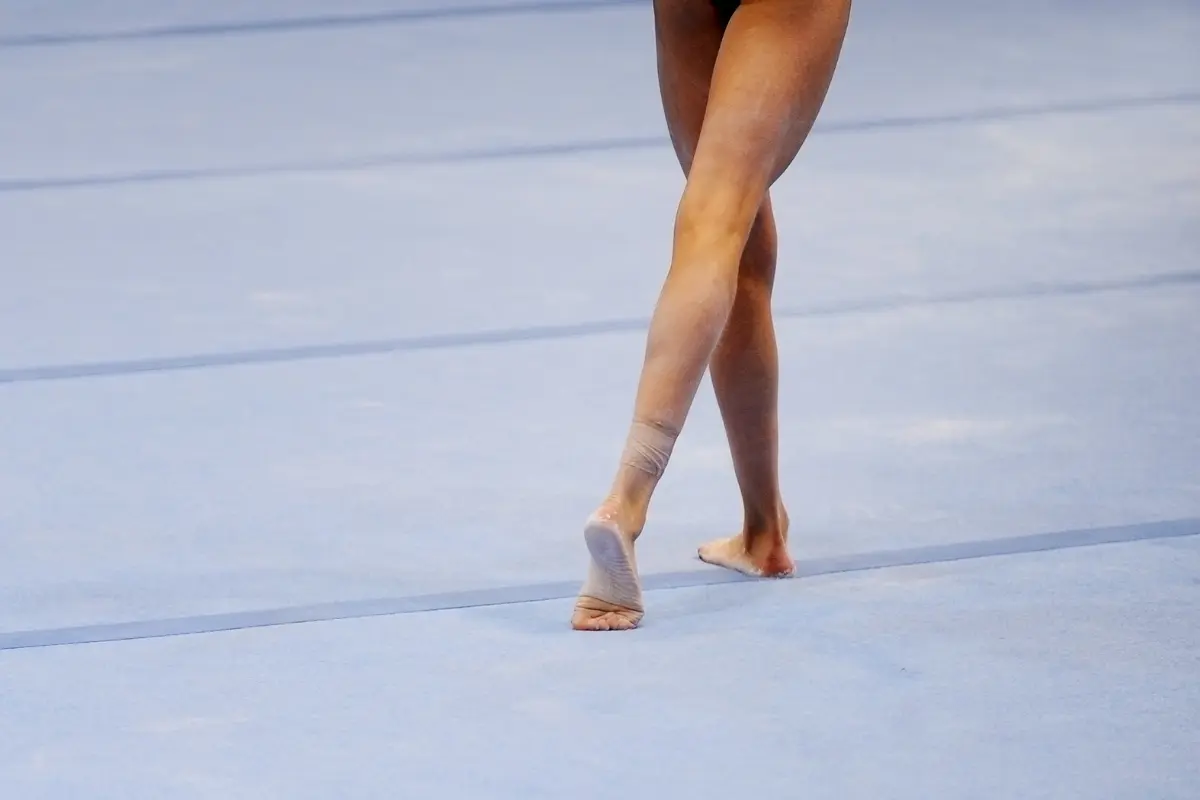In gymnastics, the precision and control exhibited during routines are key factors that contribute to a gymnast’s overall performance. While the execution of skills, artistry, and difficulty are paramount, even small errors can significantly impact the final score.
One such error is a step out of bounds. Whether it occurs during a floor exercise or on a balance beam, stepping out of bounds is a violation that results in specific deductions from the gymnast’s score.
What Does “Out of Bounds” Mean in Gymnastics?
A step out of bounds occurs when a gymnast moves beyond the designated boundary lines during their routine. Each gymnastics apparatus (whether it’s the floor, balance beam, or vault) has specific areas marked by boundaries, and stepping outside these limits is considered an error.
- On Floor Exercise: The floor exercise has clearly marked boundary lines that define the perimeter of the performance area. If a gymnast steps outside the area, they are said to have “stepped out of bounds.”
- On Balance Beam: While the beam is narrow, stepping off the edge, even slightly, counts as a mistake.
- On Vault: Although stepping out of bounds isn’t directly an issue in vaulting, if the gymnast lands outside the designated mat area after performing their vault, this counts as an error.
These boundaries exist to ensure safety, consistency, and fairness, so stepping out is not taken lightly in competition.
The Impact on Scores: Floor Exercise, Balance Beam, Vault
In gymnastics, each apparatus requires a different set of skills, precision, and control. A step out of bounds, although a small error, can have a significant impact on the gymnast’s score, especially in high-level competitions.
1. Floor Exercise
The floor exercise involves dynamic tumbling passes, leaps, and acrobatic moves performed on a large, rectangular mat with clear boundary lines. Stepping out of bounds during this routine is one of the most common errors that gymnasts face. The impact of this violation on the floor exercise score can vary depending on the severity of the step out.
- Small Step Out: A small misstep, such as a foot just crossing the boundary line or brushing the edge, generally results in a 0.1-point deduction. While this is a minor penalty, it still impacts the gymnast’s score, particularly in a competitive setting where every tenth of a point counts.
- Large Step Out: A more noticeable violation, such as stepping completely outside the boundary lines, results in a 0.2 to 0.3-point deduction. This is often considered a more severe error, as it suggests a lack of control or spatial awareness during the tumbling pass.
- Multiple Step Outs: If a gymnast steps out of bounds multiple times during the same routine, the deductions can add up. For example, two out-of-bounds steps may result in a 0.2 to 0.4-point deduction, depending on the extent of the violation. Multiple step outs are especially detrimental in competitions with close scoring, as they can make the difference between first and second place.
2. Balance Beam
The balance beam, being a narrow 4-inch wide apparatus, presents a higher risk for stepping out of bounds. Because of its limited surface area, any deviation from the beam can lead to an immediate deduction. Gymnasts must maintain balance and control throughout the routine to avoid stepping off or touching the floor outside the beam.
- Complete Step Off: If a gymnast’s foot or hand steps completely off the beam and touches the floor, a 0.2-point deduction is typically applied. This deduction reflects the loss of balance and control, which is critical in beam routines. A step off the beam is seen as a significant error since it disrupts the flow and consistency of the performance.
- Partial Step Off: If only part of the foot or hand steps off the beam or if the gymnast struggles to maintain balance but does not fully step off, a 0.1 to 0.2-point deduction may be applied. This less severe penalty can still impact the gymnast’s score, especially if the error disrupts the routine’s presentation or flow.
3. Vault
The most common time a gymnast may step out of bounds during the vault is during the landing. If the gymnast steps outside the designated landing area, a 0.1 to 0.2-point deduction can be applied. This deduction is usually minor compared to those for floor or beam, as the vault routine is short and the gymnast’s goal is to execute a clean landing without losing control.
Summary of Deductions by Apparatus:
| Apparatus | Impact of Step Out of Bounds | Typical Deduction |
|---|---|---|
| Floor Exercise | Small misstep outside the lines | 0.1-point deduction |
| Large step or full step out | 0.2 to 0.3-point deduction | |
| Multiple step outs | 0.2 to 0.4-point deduction | |
| Balance Beam | Foot or hand steps off the beam completely | 0.2-point deduction |
| Partial step off or loss of balance | 0.1 to 0.2-point deduction | |
| Vault | Stepping out during the landing | 0.1 to 0.2-point deduction |
| Stepping out during the run-up (less common) | Minimal or no deduction |
Artistry and Composition Deductions
While stepping out of bounds is usually not considered an artistry issue, the disruption caused by such an error can sometimes impact the flow or presentation of the routine. If a step out leads to a noticeable break in rhythm or a shift in form, it may result in a minor artistry deduction
However, the primary deduction for a step out of bounds will always be execution-related.
Can a Step Out of Bounds Be “Fixed”?
Once a gymnast steps out of bounds, the deduction is final. However, there are ways to minimize the impact of this error:
- Controlled Tumbling Power: Tumbling passes are often where gymnasts risk stepping out. Refining their power output and amplitude allows them to perform difficult skills without overshooting the mat. Gymnasts practice using the exact force needed to stay within bounds, fine-tuning their power for each pass.
- Spatial Awareness Drills: Coaches implement drills specifically designed to enhance a gymnast’s spatial awareness. Through repeated practice within the boundaries, gymnasts learn to “feel” the space around them, developing an intuitive understanding of where the mat edges are with their movements.
- Precision Landings: Gymnasts spend time practicing pinpoint landings, ensuring their feet meet the floor exactly as intended. Controlled landings, especially after high-energy passes, reduce the risk of momentum carrying them over the boundary lines.
- Marker or Visual Cues: Some gymnasts place small visual cues within the mat space to use as reference points. These help them gauge their position mid-routine, enabling them to adjust as needed to remain centered and avoid drifting toward the edges.
- Foot Placement Adjustments: Adjusting foot placement on certain moves, such as pivots and leaps, can keep gymnasts within bounds while still allowing dynamic expression. For instance, keeping foot placements slightly inward during directional changes minimizes the risk of crossing over lines.
In conclusion, while a step out of bounds cannot be “fixed” once it happens, gymnasts can mitigate the impact of the deduction by finishing their routine strongly, avoiding further mistakes, improving spatial awareness, and maintaining excellent technique and artistry for the rest of the performance. These factors combined help to reduce the overall effect on their final score.





